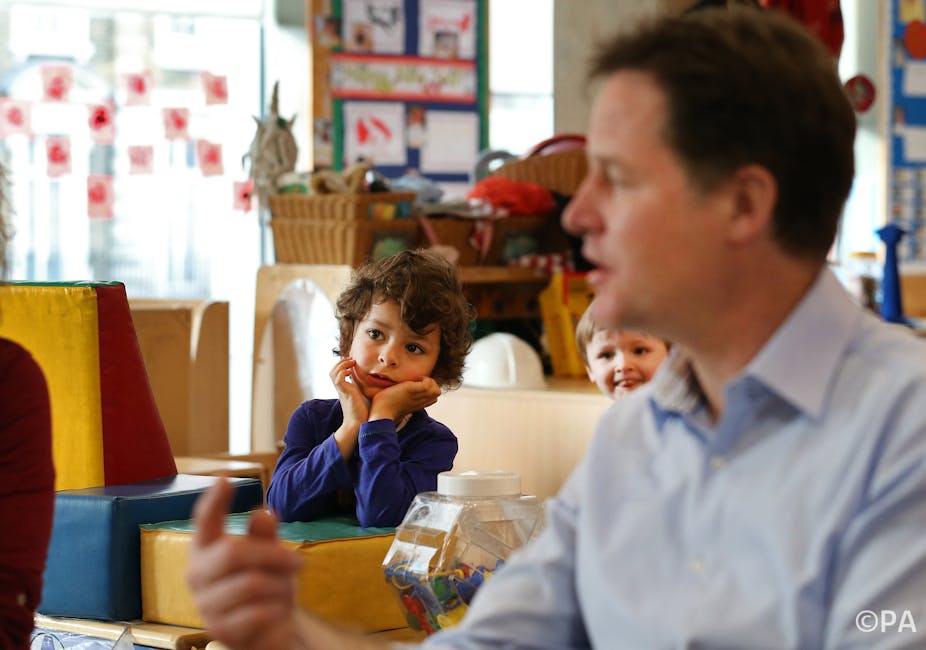The coalition has placed a series of new plans on the table with regard to childcare and early years education. Most eye-catching is the new “tax-free childcare” scheme: from September 2015, for every 80 pence parents pay into a special childcare account, government will add 20 pence, up to a maximum annual government contribution of £2,000 per child.
For universal credit recipients, government has pledged to meet 85% of childcare costs, rather than 70% under existing plans. Finally, an early years pupil premium will be introduced, with £50m of extra funding set aside for schools and nurseries to use on helping disadvantaged three and four-year-olds.
Additional investment in the childcare sector is certainly welcome. Funding on services for very young children in the UK has risen dramatically in recent decades, rising nearly four-fold during Labour’s time in office.
But we still lag behind countries doing the most effective job in providing affordable and high-quality childcare which is accessible to all, such as Norway and France. In recent international comparative work, my colleagues Ludovica Gambaro, Jane Waldfogel and I have argued that funding must continue to rise to deliver further progress. But has the government chosen the right way to invest the extra money?
Boost prices, not quality?
The bulk of the new money – an estimated £750m a year – will be spent on the new childcare accounts. These have a certain attraction: they are clear and transparent, allow other adults to pay in, and will reach considerably more people than under the existing employer childcare voucher scheme.

The lack of affordable childcare is an area where the UK stands out poorly in international comparisons – even the highest earners in the Netherlands pay just 66% of costs. At least now British parents will pay a maximum of 80% of childcare costs, rather than 100% at present.
And yet there are at least two reasons that this new system seems poorly designed and ill-thought out. First, in many other countries, fees are income-related, which means that government subsidies are higher the lower a person’s pay.
Instead, this new flat-rate 20% system sees a higher subsidy for parents who can afford to spend more – on more hours or on higher quality – which appears regressive and counter-intuitive.
Second, in a context in which a strong for-profit sector is in operation, there must be concerns that additional government resources will simply boost prices and profits, rather than increase either affordability or quality.
A strong recommendation from our international work is that government funding needs to come with clear strings attached. In Norway, public funding to privately-owned kindergartens is conditional not only on strict quality criteria, such as graduate staff qualifications, but also on profits being “reasonable” and the share of the company’s income spent on staff being comparable to that in kindergartens run by the local authority. It is a major worry that in the UK, this new funding has no such strings.
There is good evidence that graduate qualifications for early-years staff are key in delivering high-quality provision, with the greatest impact on poorer children. Spending so much additional money on subsidising childcare for even the wealthiest families in society, and nothing on investing in more qualified staff, particularly as free places are expanded to reach more disadvantaged two-year-olds, seems a terribly wasted opportunity.
Still lagging internationally
Raising the share of childcare costs covered for universal credit recipients from 70% to 85% certainly makes every sense. The Resolution Foundation has pointed out that under the previous 70% rule, second earners in low-income households faced very low or even negative incentives to go to work.
The reduction of the share of childcare costs met under Working Tax Credit from 80% to 70% in April 2011 was one of the coalition government’s least logical moves, hitting just those families it professed to support. This decision repairs that damage; though it is worth noting that low-income working households in the UK will still pay a higher share of childcare costs than in many of our European neighbours. In the Netherlands low-earners pay just 3.5%, for example.
Little funding for pupil premium
What of the early years pupil premium, which will give nurseries and schools that look after disadvantaged three and four-year-olds an additional funding boost? Exactly how this will operate is unclear, but the basic principle is sound.
Currently, nurseries and schools effectively receive a flat-rate payment per child, regardless of their background. Although local authorities can provide additional supplements for disadvantage, few do so because they receive no additional funds from central government.
Children with fewer resources at home are likely to need additional support in school and nursery, a principle that is well-established in relation to compulsory schooling. For many years, more resources have been channelled to poorer areas and schools with a more disadvantaged intake, most recently in the form of the pupil premium. Extending this principle down into early education is in the best interests of children who have most to gain from high-quality early education.
Nevertheless, while the move is a step in the right direction, we should keep an eye on the scale of the proposed investment: £50m is not very high in the context of around £4.4 billion spent on free nursery places for three and four-year-olds. There are around 1.2m children accessing these places, so if the money is targeted on the poorest 20%, these children will receive an extra £200 each on top of current spending of around £3,500 each. Not negligible, and certainly welcome, but unlikely to transform children’s experience.

